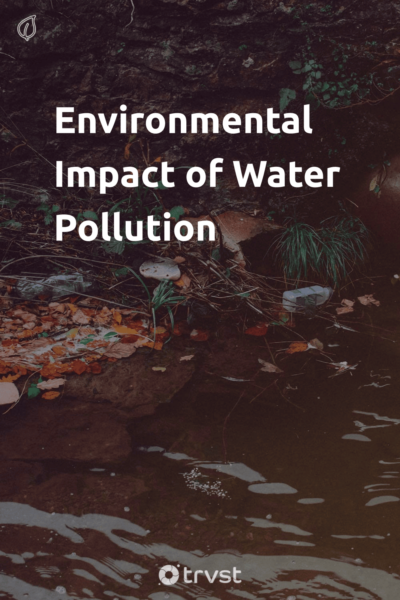Environmental Impact of Water Pollution
Safe, clean water is a natural resource many people take for granted. After all, 71% of the earth’s surface is covered with water. However, about 80% of diseases and half of child deaths globally stem from poor water quality2. Over 1 million marine animals are killed yearly because of plastic debris in the ocean5. Mass fish deaths are also becoming a common occurrence all over the world.
Water is essential for life, but polluted water is slowly draining life from our planet. Read on to learn more about the impact of water pollution on the environment.
Related Read: Water Pollution Facts & Statistics.
What is water pollution?
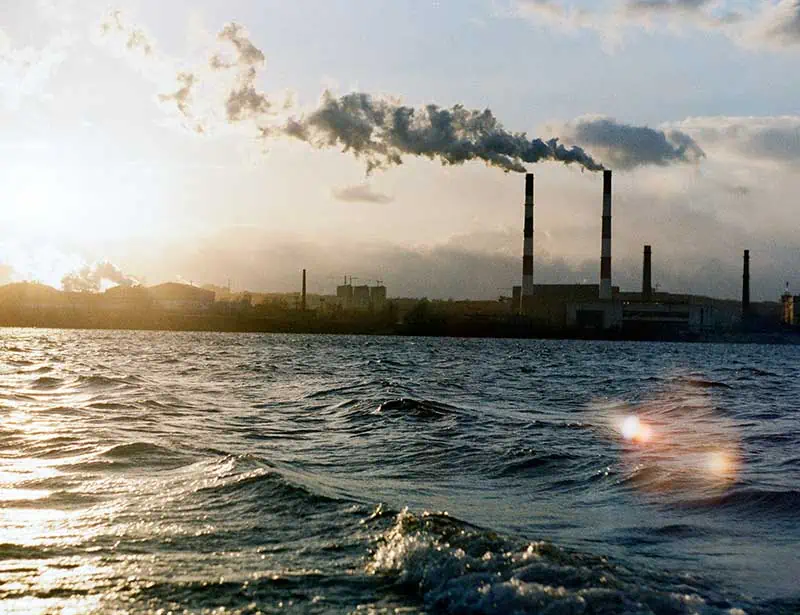
Water pollution occurs when harmful substances like chemicals, solid waste, or harmful pathogens contaminate it and degrade the water quality, making it dangerous to drink or use for other purposes.
After air pollution, water contamination is the most prevalent type of environmental pollution. Any water body can be polluted, from water stored in reservoirs to water in aquifers, rivers, lakes, and oceans.
Causes of water pollution
Water pollution can occur due to natural influences but human activities also contribute in no small measure. Below are some water pollutants.
Eutrophication
Nutrient pollution or eutrophication occurs when surface water bodies like lakes, marshes, swamps, estuaries, and oceans get overridden with plant nutrients like nitrogen and phosphorus. Reservoirs are also susceptible to eutrophication because of long water residence duration and other complex dynamics.
Sources of excessive nutrients include domestic sewage, animal waste, nitrogen fertilizers, and industrial wastewater. Air pollution also contributes to the problem as nitrogen oxides are released from burning bushes or fossil fuels.
Agricultural chemicals
Farmers often use pesticides, insecticides, and herbicides to protect crops from pests, diseases, and plant-killing weeds. Farmers use nitrogen fertilizers to guarantee high yields. Those products contain toxic chemicals. Additionally, livestock waste contains pathogens and nutrients.
These contaminants seep into groundwater and wash our waterways when it rains. Agriculture is the primary pollutant of rivers and streams in the United States4. It is the second largest contributor to wetland pollution and lakes' third primary pollution source.
Related read: Environmental Impact of Pesticides.
Industrial waste
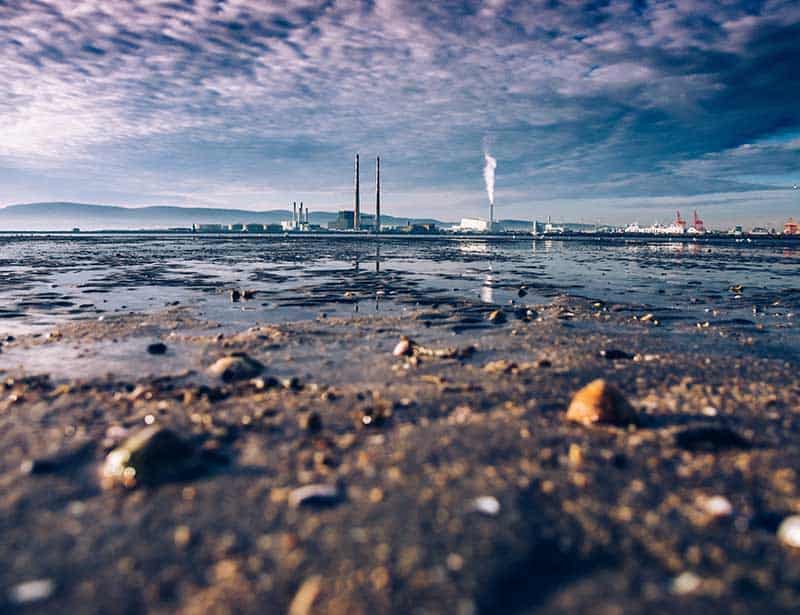
The pulp and paper industry, textile industry, food industry, iron and steel, leather industry, and nuclear industry are some industries that use up a great deal of water. About 80% of industrial and municipal wastewater gets discharged into the environment without treatment.
Also, factories sometimes accidentally release or improperly dispose of contaminants like heavy metals, oils, solvents, and toxic sludge. Factories contribute about 45% of the 1 million tons of oil pollution in marine environments yearly.
Radioactive waste
Radioactive materials may come from nuclear power plants, uranium mining, and the production and testing of military weapons. Hospitals and universities also use radioactive substances for medicine and research.
Improper disposal of radioactive waste can harm marine life and cause serious human health issues. Public drinking water is usually filtered for radionuclides. However, trace quantities persist.
Domestic wastewater
Domestic wastewater refers to the used water we send down our drains daily. It may come from the kitchen, bathrooms, washing clothes, body care, or general cleaning.
Some cleaning, personal care, or laundry products contain toxic substances like phthalate, parabens, or formaldehyde. They accumulate in the water supply system and become dangerous to humans and the environment.
The term also covers rainwater runoff which carries vehicle oil drips, grease, and road salts into our waterways.
Marine debris
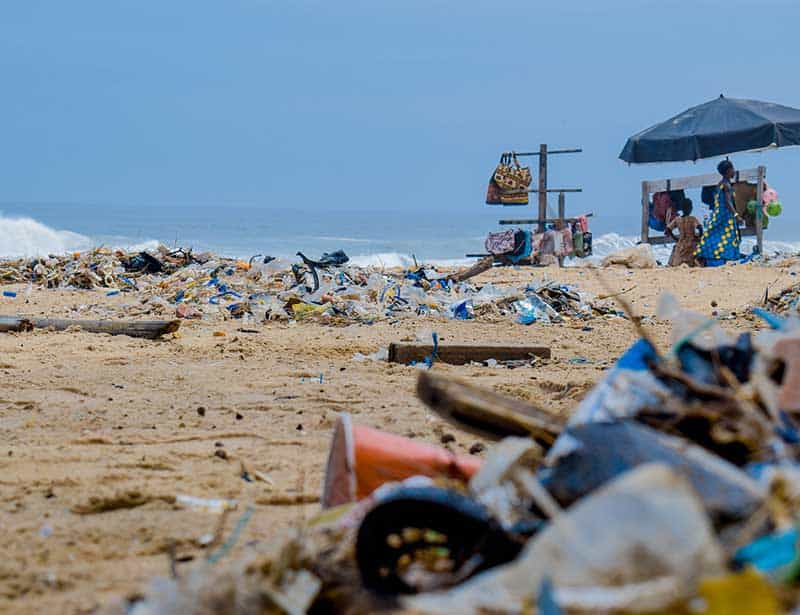
Somehow, solid waste like discarded plastic bags, soda cans, rubber, paper, wood, and textiles find their way into our waterways. Sometimes they are swept there by rainfall, other times by the wind, and some folks randomly throw stuff into waterways.
Even abandoned fishing gear, water-related recreational equipment, and derelict vessels are also marine debris. Marine debris can even be microscopic, but microplastics are every bit as dangerous as large marine garbage patches.
Marine debris has unpleasant consequences for human and wildlife health.
Related read: Environmental Impact of Microplastics.
Fossil fuel extraction
Whether deep sea drilling or fracking, fossil fuel extractions created tremendous amounts of oil pollution. Oil production uses large amounts of chemicals and creates what we know as oilfield brine or produced water.
Oilfield brine is considered very dangerous because of its high salt content and hydrocarbons. This water is stored in special wells so it doesn't lead to marine pollution.
There are also oil spills and fires, which have disastrous consequences for marine life.
Inadequate water treatment

The average assumption is that wastewater gets rigorous treatment at sewage treatment plants. However, the facts show that we discharge more than 80% of sewage generated by human activities into rivers and oceans without any treatment. Inadequately treated human waste is one of the most significant contributors to water pollution.
In areas experiencing water shortages, like China, farmers have taken to irrigating with untreated or partially treated wastewater. This causes irrigation-induced salinity, degrading soil and water quality.
Climate change
Unnaturally warm water due to global warming, trash dumping, chemicals, or microorganisms is a form of water pollution. It is called thermal pollution.
Warm water holds less oxygen compared to cold water. That makes it difficult for marine life to thrive. Also, mass fish deaths are more common with climate change-induced water temperature rise.
Impact of water pollution on the Environment
What is the environmental impact of water pollution?
Water pollution affects both land and aquatic ecosystems. It can turn healthy ecosystems into lifeless wastelands and increase carbon pollution.
1. Habitat degradation

Eutrophication typically causes harmful algal blooms. The algae will deplete water oxygen so much that aquatic life cannot survive. Areas like that are called dead zones.
Studies have shown that about 65% of the estuaries and coastal waters in the contiguous U.S. have been degraded by eutrophication. It is interesting to note that the second-largest dead zone in the world is in the U.S.
Sodium and salinity pollution degrades soil quality, reduces soil nutrients, and increases its pH. It also makes the land more susceptible to weeds, soil erosion, and less soil oxygen. More so, it can pollute groundwater and other freshwater sources.
2. Ocean acidification
When the overgrowth of plants and algal blooms caused by nutrient overload eventually decomposes, they produce large amounts of carbon dioxide. That reduces the pH of seawater, resulting in ocean acidification.
Ocean acidification changes the chemistry of entire aquatic environments. It interferes with the development of marine life. Fish and shellfish grow comparatively slowly. It can also prevent mollusks like clams, oysters, scallops, and mussels from developing healthy shells. Coral reefs may also be endangered.
Changes in ocean chemistry cause the marine food web to become unbalanced. The increase or decrease of one species may threaten the survival of other aquatic organisms.
Related read: Ocean Facts Exploring the Vast Blue Expanse.
3. Endangers aquatic organisms
Thermal pollution causes fish to be less active and eat less. They are in danger of starving. Water temperatures higher than usual jeopardize most fish's immune systems.
Debris is another way fish sustain an injury or die. Fish can get trapped, strangled, or suffocated by abandoned fishing nets and plastic bags. Fish can suffer from starvation when they mistakenly ingest bits of plastic as food. Then they cannot eat as the plastic won't digest to make space for more food.
Discarded fishing gear and other types of debris harm more than 800 different species of marine life. Let's not forget that fish swallow tons of carcinogenic microplastic as they feed.
Related read: Plastic pollution facts and statistics.
The economic impact of water pollution
Water pollution can have serious health consequences for humans, but many people are unaware of its dire economic ramifications. According to the World Bank, water pollution stunts one-third of the affected regions' economic growth. Below are some effects of water pollution on the economy.
1. Marine vessel damage
Unchecked aquatic plant growth due to eutrophication can prove problematic for the fishing and water transport industry. These plants can slow down vessel speed or warp its engine.
Marine debris can also get into engines and cause severe vessel damage. Not only that, excessive salinity can corrode machinery and infrastructure like bridges.
2. Decreasing food supply
Slow-growing fish, contaminated seafood, mass fish deaths, and dead zones mean smaller harvests for commercial fishing companies. Yearly loss estimates of the seafood industries run up to over $10 million.
Even local subsistence fishing is not spared. Folks living in areas where fish is their primary food source will also be severely affected. They might suffer from food insecurity and starvation.
Also, irrigation-induced salinity affects soil quality leading to poor yields. Crops that are not salt resistant will not survive. The world loses enough food to feed 170 million people yearly because of salinity.
3. Reduced value of tourism and recreational businesses
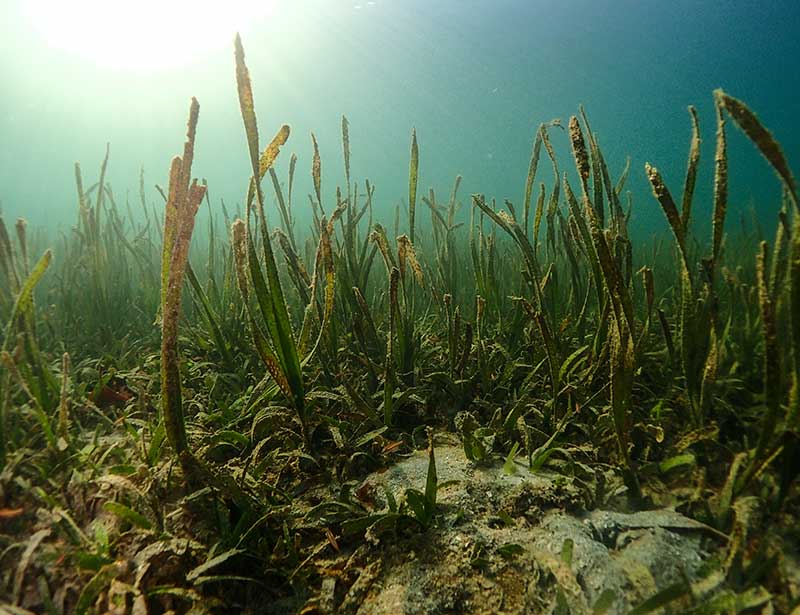
Algae-infested waters or floating garbage patches do not make recreational fishing attractive. Polluted water is causing water-related recreational firms to lose money.
A study on beaches in Orange County, California, found that reducing marine debris by 25% could bring in roughly $32 million from summer tourism and recreation within three months.
The Environmental Protection Agency says the U.S. tourism industry is losing almost $1 billion yearly from boating and fishing activities. All of that money is lost due to water contamination.
4. Higher water costs
It is challenging to use highly contaminated water for anything. That shows how vital water treatment is. However, removing pollutants from water is neither easy nor cheap. Many different pollutants are in the water system, and more may still emerge.
As treatment plans become more complex to deal with emerging pollutants, so does the cost. That cost spills over into your household's water bills. In Minnesota, for example, the drinking water cost increased from 5 to 10 cents per 1000 gallons to over $4 for the same quantity.
5. Devalued real estate
One of the effects of water pollution is that it lowers the value of waterfront properties, which would be otherwise highly profitable. At least 25% of a property’s value goes down due to the proximity of smelly, murky, contaminated water.
Impact of water pollution on human health
Most people associate water pollution-related diseases with developing countries with poor sanitation challenges. However, due to water pollution, even in developed countries with advanced sewage treatment facilities, harmful chemicals, and organisms still find their way into the human body.
1. Contaminated food poisoning
When polluted water is used for irrigating, washing, and processing crops, it can become heavily contaminated. Contamination can occur due to bacteria or residue of agricultural chemicals and heavy metals.
Consuming contaminated food can have adverse health effects. Bacteria can spread foodborne diseases like cholera, dysentery, and diarrhea. Ingesting waterborne toxic chemicals can bring on serious health issues too.
Lung cancer, hepatitis A, hormone disruption, kidney problems, reproductive damage, and altered brain function are some of the many issues related to water pollution.
2. Contaminated drinking water
Unsafe drinking water transmits illnesses like diarrhea, cholera, typhoid, giardia, dysentery, and even polio. High water salinity is also associated with hypertension and high blood pressure.
Each year, 485 000 people die from diarrhea-related illnesses. Over 20 million people in Bangladesh are at high risk of hypertension from drinking water with high saline content1.
3. Skin diseases
Drinking, swimming, or bathing in polluted water can damage skin health. Swimming in contaminated water can expose a person to skin rashes and infections. Swimmers are 3 1⁄2 times more likely to get skin diseases than folks who don't swim.
Heavy metals like arsenic in drinking water can bring on keratosis and melanosis. Research has also linked water pollution to scabies and skin cancer.
4. Swimming-related diseases
Swimming in polluted water can expose an individual to pathogens that cause various illnesses. A common one is gastroenteritis. Its symptoms include nausea, vomiting, stomachache, headache, or fever.
Algal blooms contain cyanotoxins that produce symptoms closely resembling hay fever. Exposed swimmers may notice a sore throat, coughing, or more severe issues like liver or kidney damage.
4. Ingesting microplastics
Microplastics seem like an ocean problem but find their way up the food chain through human seafood consumption. A person can also ingest microplastics through drinking water.
Possible effects of ingesting microplastics include oxidative stress, immune system disruption, neurotoxicity, and metabolism alteration. Microplastics may also build up within tissues and cause swelling3.
Conclusion
The environmental impacts of water pollution can be fatal to human health and aquatic life. It can also have devastating consequences on our social and economic development.
Somehow, everyone has contributed to the water pollution problem. The way forward is to reduce your wastewater and buy cosmetics and cleaning supplies with fewer chemicals.
We can't contain water pollution by a line on a map as contaminated water from one area spills into the waters of another. So you can also lend your voice to improving water quality worldwide. You can also donate to NGOs cleaning up the marine environment and providing sanitation services.
For more information, check out our articles on World Water Day and the Importance of Water Conservation.
| 1 |
Impact of Salinity on Infectious Disease Outbreaks: Experiences From the Global Coastal Region | SpringerLink. |
| 2 |
Lin L, Yang H and Xu X (2022) Effects of Water Pollution on Human Health and Disease Heterogeneity: A Review. Front. Environ. Sci. 10:880246. doi: 10.3389/fenvs.2022.880246 |
| 3 |
Bhuyan, M. S. (2022, February 28). Effects of Microplastics on Fish and in Human Health. Frontiers. |
| 4 |
Water pollution from agriculture: a global review (pdf). Food and Agricultural Organization of the United Nations. Javier Mateo-Sagasta (IWMI), Sara Marjani Zadeh (FAO) and Hugh Turral. 2017. |
| 5 | Plastic Debris in the Ocean. Authors: Peter Kershaw (chair), Saido Katsuhiko, Sangjin Lee, Jon Samseth and Doug Woodring Science writer: John Smith |
Jen’s a passionate environmentalist and sustainability expert. With a science degree from Babcock University Jen loves applying her research skills to craft editorial that connects with our global changemaker and readership audiences centered around topics including zero waste, sustainability, climate change, and biodiversity.
Elsewhere Jen’s interests include the role that future technology and data have in helping us solve some of the planet’s biggest challenges.

